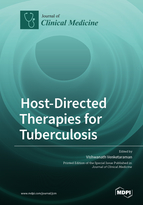Host-Directed Therapies for Tuberculosis
A special issue of Journal of Clinical Medicine (ISSN 2077-0383). This special issue belongs to the section "Pulmonology".
Deadline for manuscript submissions: closed (30 June 2019) | Viewed by 34906
Special Issue Editor
Interests: mycobacterial diseases; tuberculosis; host immune responses; pathogenesis
Special Issues, Collections and Topics in MDPI journals
Special Issue Information
Dear Colleagues,
TB is considered as one of the oldest documented infectious diseases in the world and is believed to be the leading cause of mortality due to a single infectious agent. Mtb, the causative agent responsible for TB, continues to afflict millions of people worldwide. Furthermore, one-third of the entire world's population has latent TB. Consequently, there has been a worldwide effort to eradicate and limit the spread of Mtb through the use of antibiotics. However, management of TB is becoming more challenging with the emergence of drug-resistant and multi-drug resistant strains of Mtb. Furthermore, when administered, many of the anti-TB drugs commonly present severe complications and side effects. Novel approaches to enhance the host immune responses to completely eradicate Mtb infection are urgently needed. This Special Issue will therefore cover most recent advances in the area of host-directed therapies for TB.
Prof. Dr. Vishwanath Venketaraman
Guest Editor
Manuscript Submission Information
Manuscripts should be submitted online at www.mdpi.com by registering and logging in to this website. Once you are registered, click here to go to the submission form. Manuscripts can be submitted until the deadline. All submissions that pass pre-check are peer-reviewed. Accepted papers will be published continuously in the journal (as soon as accepted) and will be listed together on the special issue website. Research articles, review articles as well as short communications are invited. For planned papers, a title and short abstract (about 100 words) can be sent to the Editorial Office for announcement on this website.
Submitted manuscripts should not have been published previously, nor be under consideration for publication elsewhere (except conference proceedings papers). All manuscripts are thoroughly refereed through a single-blind peer-review process. A guide for authors and other relevant information for submission of manuscripts is available on the Instructions for Authors page. Journal of Clinical Medicine is an international peer-reviewed open access semimonthly journal published by MDPI.
Please visit the Instructions for Authors page before submitting a manuscript. The Article Processing Charge (APC) for publication in this open access journal is 2600 CHF (Swiss Francs). Submitted papers should be well formatted and use good English. Authors may use MDPI's English editing service prior to publication or during author revisions.
Keywords
- host-directed therapies for tuberculosis
- immunoadjuvants
- supplements
- repurposing the drugs







